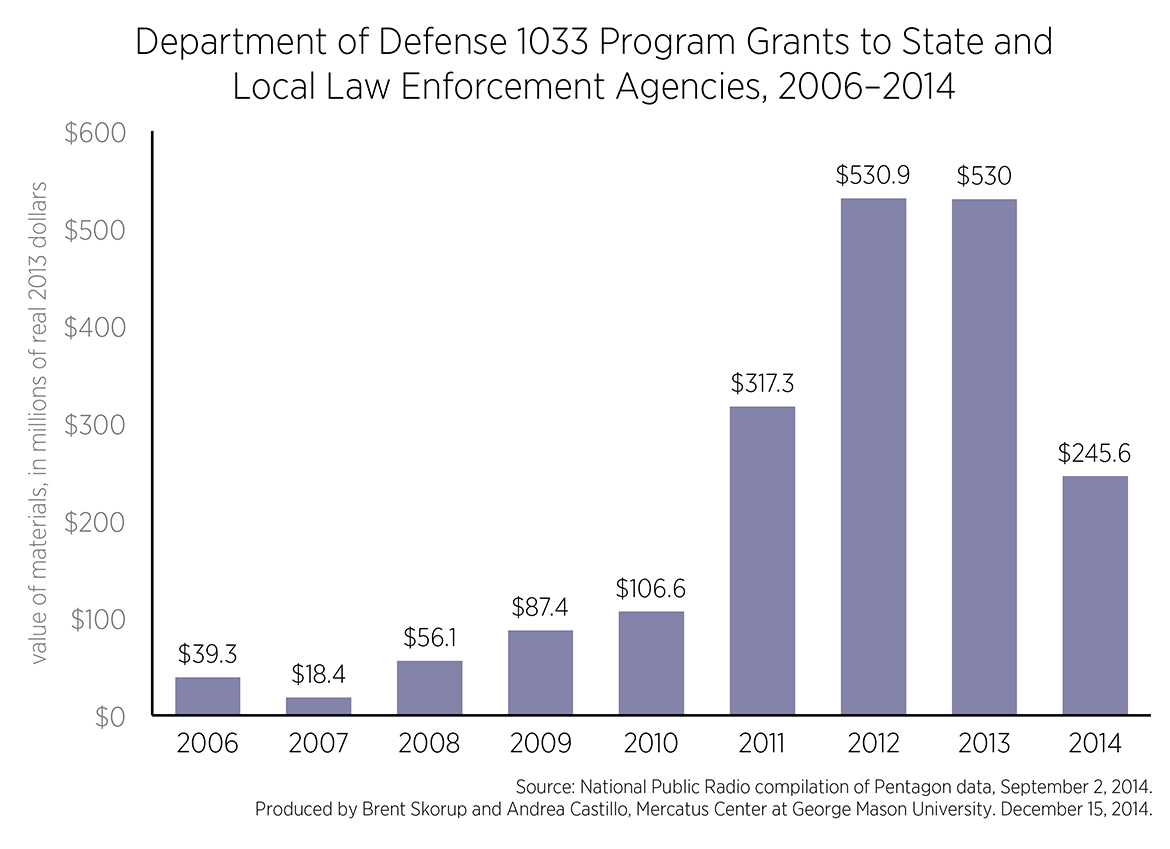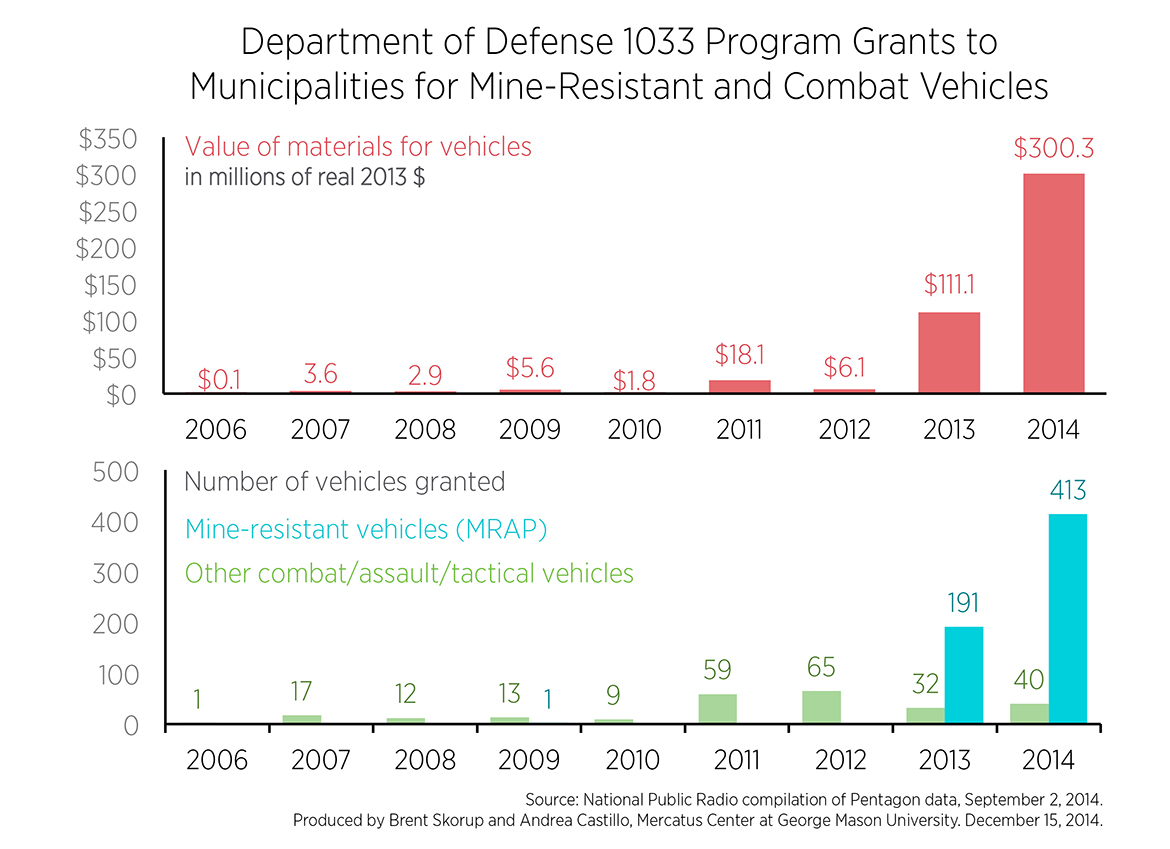- | Government Spending Government Spending
- | Data Visualizations Data Visualizations
- |
Breaking Down Department of Defense Grants to State and Local Law Enforcement
This week’s charts use data from a National Public Radio compilation of public Department of Defense records of grants issued to state and local law enforcement bodies through its Excess Property Program, also known as DoD 1033. The charts display the total value of all known grants to municipalities in real 2013 dollars along with the total value and number of mine-resistant and combat vehicles distributed from 2006 to April 2014.
Recent high-profile allegations of police misconduct coincide with a growing consensus spanning the right and left that police militarization is an increasingly serious problem in America. A Reason/Rupe poll from December 2013 finds that a large majority of Americans believe that law enforcement does not require local police departments to employ military-grade drones, weapons, and armored vehicles. While the Department of Defense has been providing growing amounts of in-kind assistance to local and state municipalities since at least 1990, the trend of granting mine-resistant ambush protected (MRAP) and other combat vehicles to local law enforcement agencies is a more recent—and visible—phenomenon. The militarization of law enforcement is problematic because it constitutes both a cause and a consequence of diminishing trust between US government bodies and its citizens.
This week’s charts use data from a National Public Radio compilation of public Department of Defense records of grants issued to state and local law enforcement bodies through its Excess Property Program, also known as DoD 1033. The charts display the total value of all known grants to municipalities in real 2013 dollars along with the total value and number of mine-resistant and combat vehicles distributed from 2006 to April 2014.
The 1033 program was created through the National Defense Authorization Act of 1997 as a restructured version of the earlier 1208 program launched in 1990. These programs empowered the Secretary of Defense to transfer excess equipment that had been over-issued or no longer needed by the Pentagon to other federal and state departments for use in “counter-drug activities.” Municipal law enforcement agencies that qualified could browse equipment listings online and apply to procure DoD equipment for their own offices. The Pentagon’s Law Enforcement Support Office (LESO), which oversees the 1033 program, notes that more than $5.1 billion worth of federal property has been transferred to other federal and state offices since the program’s inception.
The first chart displays the total known value of all items issued through the 1033 program from 2006 through April 2014 in real 2013 dollars. The items transferred range from benign materials, such as office supplies and construction tools, to more militaristic items, such as grenade launchers and armored vehicles. For many years, the data show that the Department of Defense issued more innocuous items than deadly weapons or other “militarizing” equipment. For example, in 2009, roughly $4.5 million worth of fire and safety equipment and $12.9 million in communications equipment was issued, while only $1.2 million worth of ammunition and weapons were granted. However, between 2013 and the first four months of 2014, the Department of Defense dramatically increased the number of MRAPs and other combat, assault, and tactical vehicles issued through the 1033 program.
The second chart breaks out the value and number of MRAPs and other combat, assault, and tactical vehicles granted by the Pentagon to other federal and state agencies from 2006 to late July 2014. (Because the MRAP dataset includes grants extended during May and July 2014, the value of 1033 combat vehicle grants in 2014 in the second chart exceeds the total value in 2014 on the first chart, which only extends to April 2014.) Only one MRAP vehicle was issued from 2006 through 2012, in 2009. Between 2013 and the first four months of 2014, the Department of Defense distributed 604 MRAPs and 72 other combat, assault, and tactical vehicles through the 1033 program.
These charts show that Department of Defense’s 1033 program has dramatically increased the number of MRAP and combat, assault, and tactical vehicles granted to state and local law enforcement agencies. Additionally, the total value of in-kind grants to local and state law enforcement agencies has grown overall each year from 2007 to 2012. These grants include innocuous materials like office supplies and construction materials, but they also contain military-grade surveillance and recording equipment. While some grants represent wise reuse of surplus federal equipment, this program will likely be a source of controversy so long as the donated MRAP and combat vehicles serve as manifestations of the militarization of law enforcement. Vehicles that were made to patrol warzones are increasingly employed in America’s cities. The benefits to local law enforcement agencies of operating these vehicles are outweighed by the immense costs of losing the trust of their constituents—and loss of trust is incredibly difficult to reverse.
To maintain law and order while preserving community trust, local law enforcement agencies should move away from the top-down militarized model and adopt the community policing model studied and championed by Nobel prize-winning economist Elinor Ostrom. Smaller, community-controlled law enforcement departments deliver a consistent pattern of superior results when compared to top-down, unaccountable agencies. Reforms that move local police enforcement agencies closer to this model will deliver security while maintaining trust.



